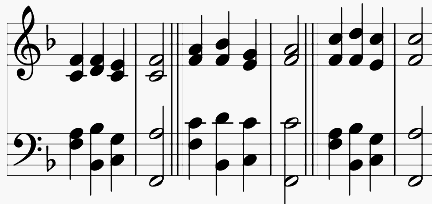Subdominant
Subdominant , and sub-dominant , refers to the chord on the fourth stage of a major - or minor scale . The term subdominant ( sous-dominante ) was introduced by Jean-Philippe Rameau and, according to today's understanding, means that, in contrast to the (upper) dominant , which is a fifth above the tonic, it is a fifth below the tonic.
Examples:
- The triad on the fourth degree of C major consists of the chord tones f - a - c . The subdominant of C major is thus the F major triad.
- The triad on the fourth degree of D minor consists of the chord tones G - b - d . The subdominant of D minor is thus the G minor triad.
In its tonal effect, the subdominant (function symbol: S, in minor: s) represents a counterweight to the dominant (D) and is often perceived as a calm pole. In terms of its direction, it is much more open compared to the dominant, which tends to return to the tonic (T / t). It is often used as an output for pending modulations. Compared to T and D (especially in the minor variant) it stands out due to its comparatively colorful sound character.
The subdominant is part of the common cadence T - S - D - T.
|
Cadence T - S - D - T
Here: T = tonic with the notes f, a and c S = subdominant with the notes b, d and f D = dominant with the tones c, e and g |
| Cadence in all three positions |
The plagalus ending as a chord progression subdominant - tonic is less compelling than the authentic ending dominant - tonic .
The effect of the subdominant can be increased by adding the major sixth (in C major a D added to the F major triad, in C minor corresponding to F a flat cd).

|
Example of a minor subdominant chord with sixth ajoutée : The sixth D is added to the subdominant chord F-A- flat -C. Then comes the dominant chord GHD and the tonic C-Eb-G. (Note: The interval As-D is a tritone with the frequency ratio 45 / 32 ).
End of “He who only lets God rule”. Theorem by Friedrich Silcher. transposed to c minor. See: Pure tuning sound sample |
The thus created Subdominantquintsextakkord was noted by Jean-Philippe Rameau described ( "l'accord de la sixte ajoutée" S 5 6 or s 5 6 ) . The abbreviation “Rameau chord” is also used. In the baroque (Bach chorale) and in the Viennese classical period it was a characteristic element of a final cadenza. In the Romantic period (e.g. Brahms, Tchaikovsky) it was often used in the minor form with plagal conclusions as a particularly attractive, emotional color effect in major keys (in C major, i.e. f-a-flat-cd).
There is also the subdominant chord with a sixth instead of a fifth, which is called a subdominant sixth chord (short: S 6 or s 6 , in C major fad, in C minor f a flat d). This chord consists of the same notes as the ladder's own triad of the 2nd degree.
Another subdominant chord is the Neapolitan sixth chord (short: "Neapolitan", s n ). It is - in minor and major alike - a variant of the minor subdominant, in which the fifth is replaced by the minor sixth, which is not in the scale (in C major and C minor, f-a-flat). Since the sound material of the Neapolitan is identical to the D flat major chord, which is far away in the circle of fifths , it is ideal for modulations .
See also
- Harmonik , for a general overview of the teaching of chord connections
- Circle of fifths , for the subdominant and dominant relationships between the keys
- Cadence , for the basic model of a chord progression
- Double subdominant
swell
- ^ Jean-Philippe Rameau , Nouveau systems, 1726
